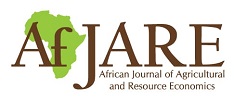African Journal of Agricultural and Resource Economics
(AfJARE)
Journal Africain d’Économie Agricole et des Ressources
(JAEAR)
Published by the African Association of Agricultural
Economists (AAAE)
ISSN 1993-3738
Volume 17, No. 4 (December 2022)
This study seeks to identify the internal and external factors determining Ethiopia’s bilateral exports and total trade flows. It uses panel data covering 21 major trading partners of Ethiopia from 2000 to 2017 and estimates an augmented fixed effects gravity model.
The present study aims to estimate the marginal cost of potable water supply and analyse the implications for more efficient, equitable and income-adequate tap water tariffs in Tunisia.
There is an emerging body of studies assessing the influence of resilience on household food security in developing countries. Yet no study has systematically analysed this theme in Zimbabwe, an area that we address.
Cette étude analyse l’efficacité des producteurs de riz dans l’allocation des ressources dont ils disposent pour la production en recueillant des données transversales auprès de 255 producteurs dans le Centre-Ouest de la Côte d’Ivoire.
This study aimed to bring forth empirical evidence of the effect of the sustained adoption of sustainable agricultural practices (SAPs) on the technical and profit efficiency of farmers. Previous studies remain inconclusive about whether the adoption of SAPs has any bearing on the efficiency of maize farmers.
This article analyses the level of integration in pastoral markets in Kenya using high-frequency data generated through a crowdsourcing endeavour. The vector error-correction model framework was used to estimate the causal relationships between the short- and long-run market price.
